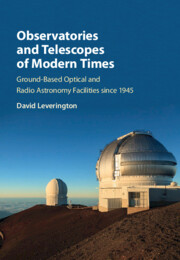 Observatories and Telescopes of Modern Times
Observatories and Telescopes of Modern Times from Part 2 - Radio Observatories
Published online by Cambridge University Press: 15 December 2016
The Early Years
Martin Ryle, Bernard Lovell and a number of other people who became leaders in British radio astronomy had worked for the British Telecommunications Research Establishment (TRE) during the Second World War. John (Jack) Ratcliffe, who had previously led a research group at Cambridge University's Cavendish Laboratory also worked at TRE as one of its top administrators. But in early 1945 Ratcliffe left TRE to rebuild his radio research group at Cambridge where he was able to attract Ryle, Derek Vonberg and F. Graham Smith amongst others.
When Ryle joined the Cavendish laboratory the sunspot cycle was on its way towards solar maximum. As a result Ratcliffe suggested to Ryle that it may be a good time to investigate the source of radio noise associated with sunspot activity that had been observed by Stanley Hey during the Second World War.(1) But unfortunately at that time a typical radar antenna, operating at a wavelength of 1.5 m, had a beamwidth of the order of 10° making it impossible to find the exact source of radio waves on the Sun. So in the winter of 1945–1946 Ryle decided to build a radio interferometer which should be able to locate the sources much more accurately. It consisted of two antennae working at 175 MHz (λ 1.7 m) at separations of up to 240 m or 140 wavelengths. Each antenna was made of eight half-wave dipoles mounted over a wire mesh reflector. With this system Ryle and Vonberg were able to show that short duration radio bursts from the Sun were often circularly polarised and came from discrete areas on the Sun's disc, and not from the disc as a whole.
Two years later Ryle and Smith used another Michelson interferometer at Cambridge to study the cosmic source Cyg A, which Hey, Parsons and Phillips had found in 1946 fluctuated over a period of a few seconds. Ryle and Smith's interferometer consisted of two groups of four Yagi antennae spaced 500 m apart, operating at 80 MHz (λ 3.75 m).(2)
To save this book to your Kindle, first ensure [email protected] is added to your Approved Personal Document E-mail List under your Personal Document Settings on the Manage Your Content and Devices page of your Amazon account. Then enter the ‘name’ part of your Kindle email address below. Find out more about saving to your Kindle.
Note you can select to save to either the @free.kindle.com or @kindle.com variations. ‘@free.kindle.com’ emails are free but can only be saved to your device when it is connected to wi-fi. ‘@kindle.com’ emails can be delivered even when you are not connected to wi-fi, but note that service fees apply.
Find out more about the Kindle Personal Document Service.
To save content items to your account, please confirm that you agree to abide by our usage policies. If this is the first time you use this feature, you will be asked to authorise Cambridge Core to connect with your account. Find out more about saving content to Dropbox.
To save content items to your account, please confirm that you agree to abide by our usage policies. If this is the first time you use this feature, you will be asked to authorise Cambridge Core to connect with your account. Find out more about saving content to Google Drive.